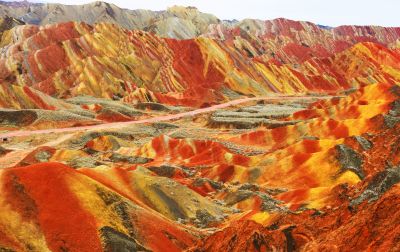
Extending along the northern slope of
Qilian Mountain in west China, Zhangye Danxia National Geological Park
in Gansu is the best representative of China's colorful Danxia landform
and the largest Danxia landscape in an arid area, with a wide variety of
landforms. Undulating fiery-red ridges together with amazing
multicolored mountain folds transform the park into an immense sea of
fire with rolling waves, earning it the reputation of China's Rainbow
Mountains and also one of the 'Top 10 Geographical Wonders of the World'
selected by the National Geographic.
Zhangye Danxia Geopark's
geological structure is formed by rocks piling on top of one another. It
means that after billions of years of weathering and water erosion,
together with the influences brought by the special geological
structure, climate change, and wind power, the red sandstones, psephites
and pelites have shaped into isolated mountains and steep rocks. The
sandstones' bright colors make the Geopark an attractive tourist
destination to experience the masterpieces of nature.
Red is the
main color of Colorful Hills. Under the sunlight, the seemingly endless
hills form a sea of fire. Some of the hills feature rock stripes in
different colors, looking like bright ribbons fluttering in the desert.
The most representative spots of this kind are the Seven-color Screen
and the Colorful Sunset, looking like a rainbow hanging in the distance.
However, scenes are totally different on the edge of this area. The
colors there turn into yellow and grey, resembling crystal shells in the
sun. Scenes are even more breathtaking at sunrise and sunset. Then, the
staggered lights and shadows thrown on the hills endow this region with
a dynamic beauty.
Stretching 25 miles (40 kilometers) from west
to east, Danxia precipices, stone columns, aiguilles and hills are
widely distributed in this region. The narrow hills in the Ice Valley
are all pointing to the sky, making this valley the Red Stone Forest of
the Great Northwest. Viewed from a distance, the rolling hills look like
temples, pagodas, and figures of Buddha, making the valley a natural
Buddhist land.